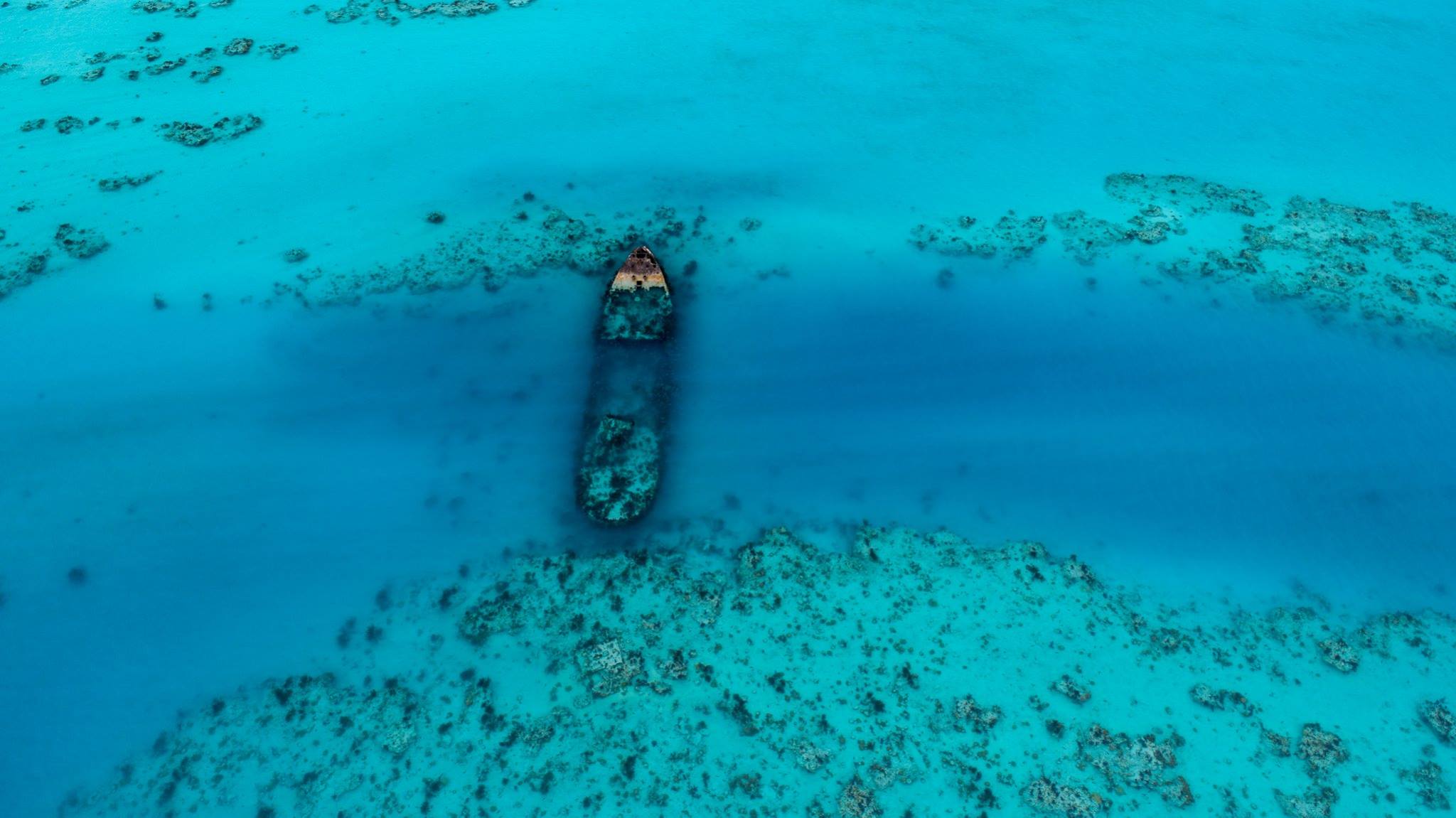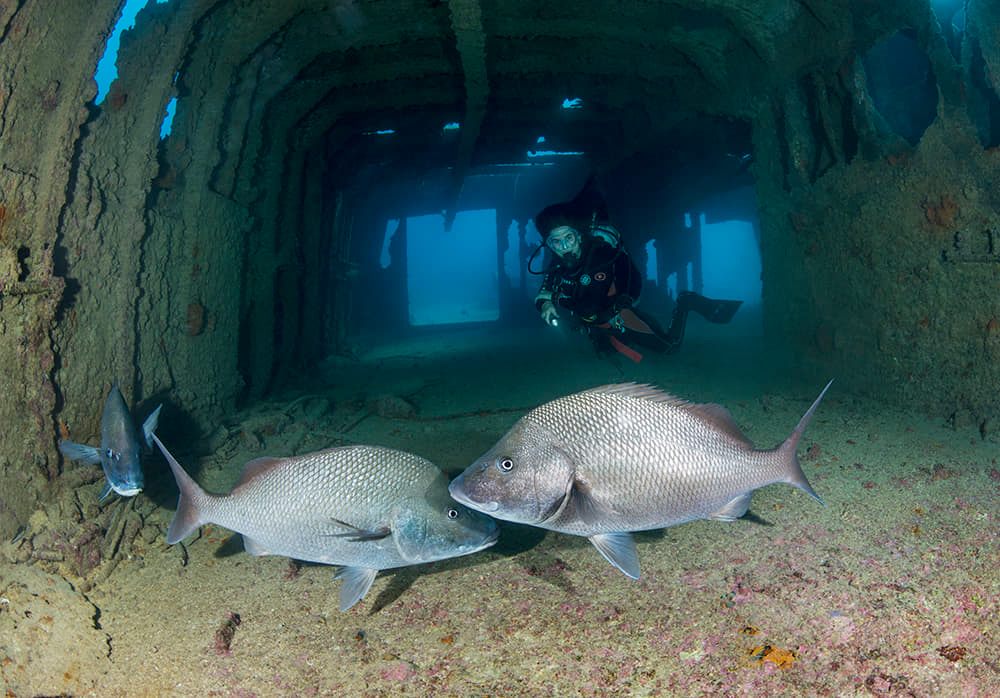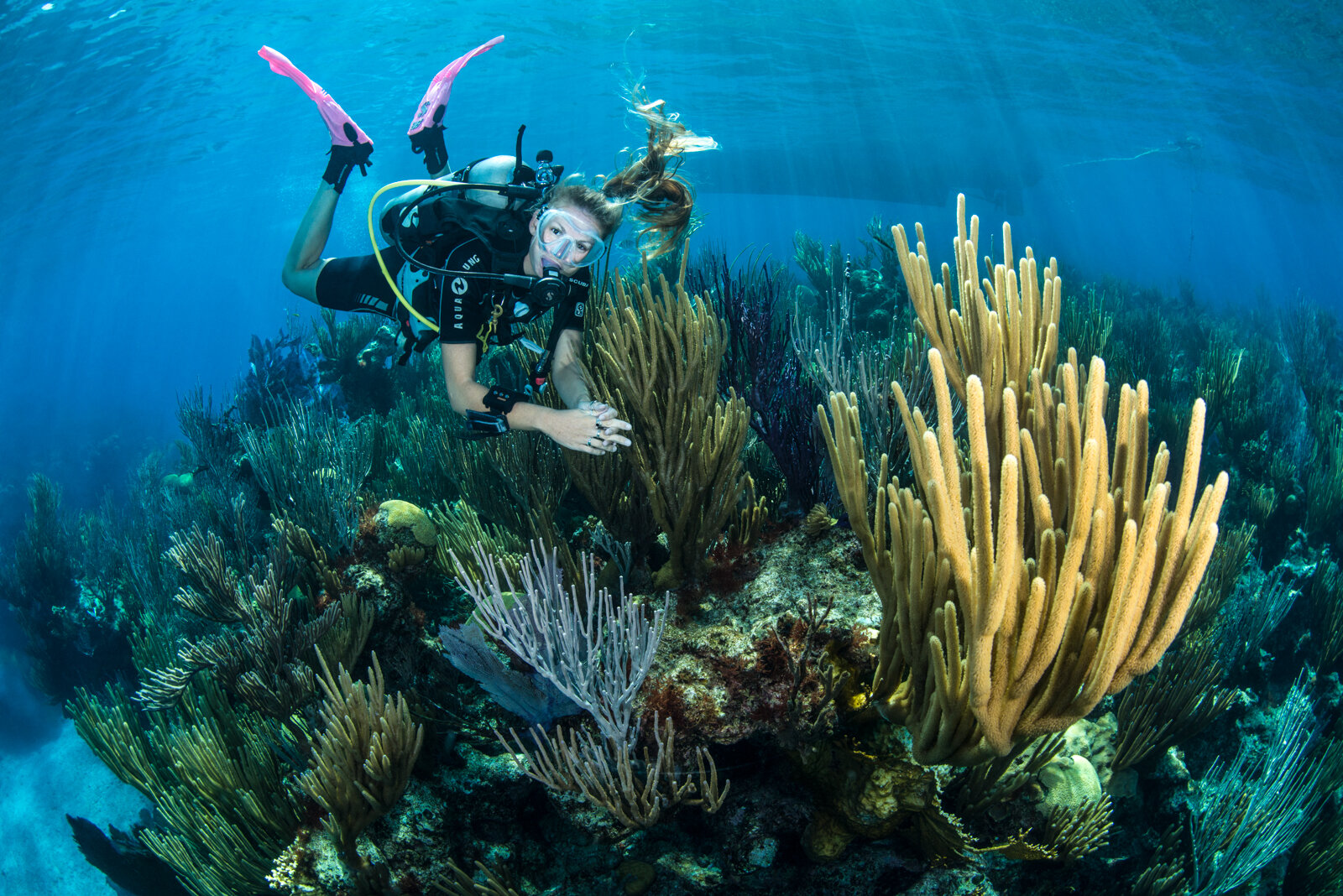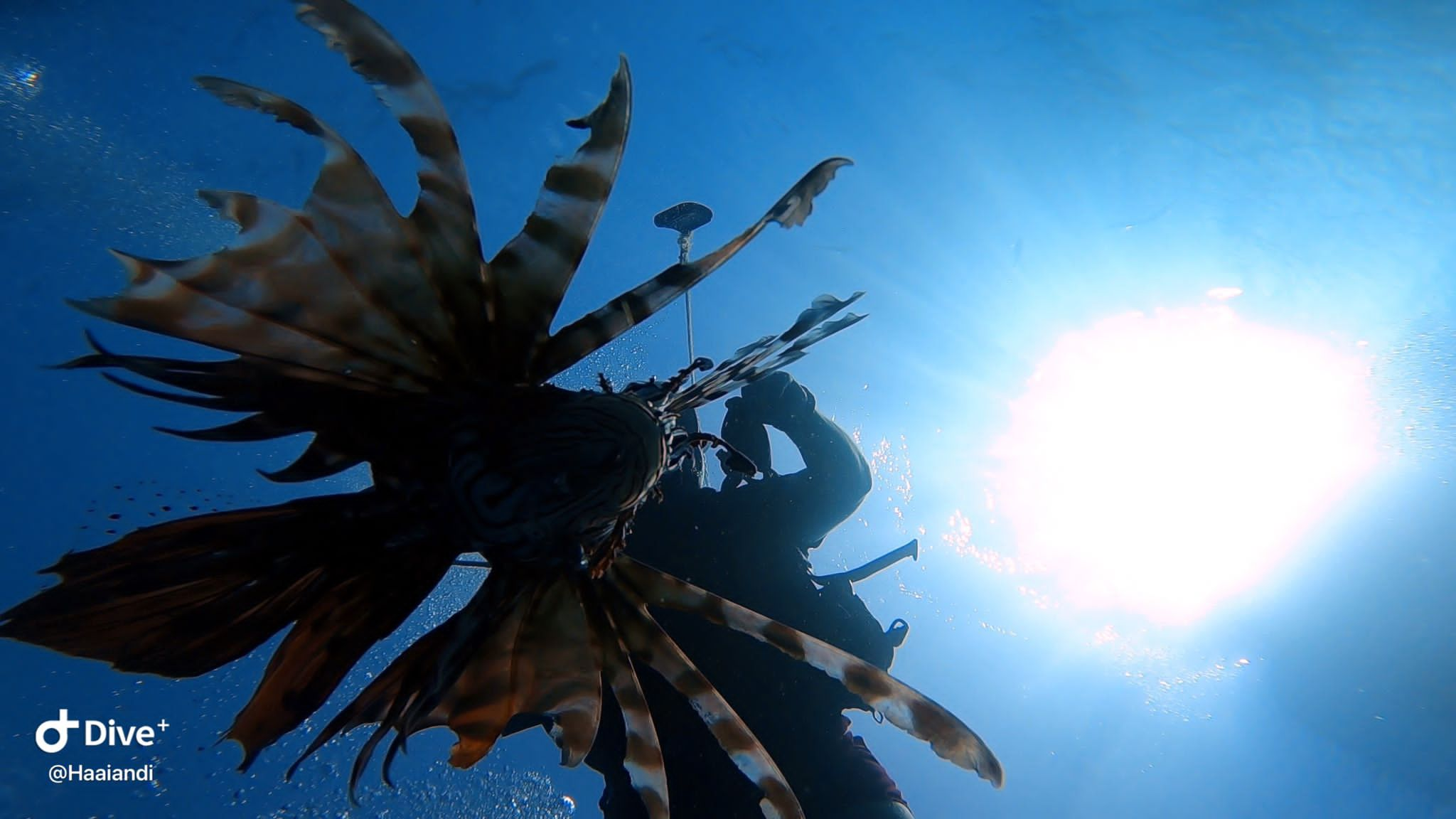News
Halloween Special Part 1: Bermuda – the ultimate destination for spooky dives

Just in time for Halloween, we take a deep dive with PADI into spooky Bermuda… check back for part 2 on Monday.
Are you a thrill-seeker who loves the call of adventure and doesn’t mind a good scare? If you’re looking for something mesmerising, intriguing, and downright creepy then look no further than Bermuda, the ultimate destination for a spooky dive.
Why Bermuda? Mysterious disappearances, real-life underwater monsters, hundreds of shipwrecks to explore – the list goes on. Found in the North Atlantic Ocean and surrounded by fringing coral reefs, Bermuda already offers fantastic diving for anyone delighted by diverse and stunning aquatic species. But if it’s the eerie and uncanny you’re after, Bermuda hits the mark too!
You may already be familiar with strange stories about the Bermuda Triangle – a peculiar region where planes and ships seem to disappear into thin air – but did you know that Bermuda is also known as the Wreck Capital of the Atlantic?
There are over 300 sunken ships scattered around Bermuda. Some even date back to the 1600’s thanks to Bermuda’s extra shallow reefs. With so many ghostly shipwrecks to explore, it’s easy to see why the Bermuda Triangle has become the stuff of myth (and no doubt nightmare for some).
Dive deep with PADI for the frightful and freaky scoop about Bermuda – read on with caution and don’t say we didn’t warn you!
PADI’s 8 Spooky Fun Facts About Bermuda
- Strange Weather and Extra Deep Waters
Bermuda is known for all kinds of bizarre natural phenomena. From ultra-extreme weather and uneven seafloors to strong electromagnetic field pulls (ever heard of electronic fog?!) and unpredictable rogue waves, it’s no wonder there have been so many shipwrecks around the island over the years. At a depth of 27,493 feet, the Bermuda Triangle is home to the deepest point of the Atlantic Ocean at the Puerto Rico Trench in the Milwaukee Depth.
- Mysterious Disappearances
The Bermuda Triangle has long been renowned as a creepy spot that pilots and ship captains alike would prefer to avoid. There are countless tales of ships, planes, and submarines that have gone missing without a trace, and while there are over 300 wrecks found on the ocean floor, many disappearances remain a mystery. It’s estimated that at least 50 airplanes and 20 ships are unaccounted for to this day.
- Magnetic Anomalies
The Bimini vortex often comes up as an oddity connected to the Bermuda Triangle. It’s described as a unique spot where compasses spin, and electronics fail to work properly. Even more strange are reports of dolphins that appear very suddenly and come right up to divers. Some attribute the anomalies to “electronic fog” which is described as an electromagnetic field that appears as a cloud over the ocean, engulfing a ship and causing its electronics to malfunction. While pilots and coast guards have indeed reported uncanny fog in the area, electronic fog remains a supernatural theory that makes the Bermuda Triangle even more mysterious.
- Fact or Fiction?
The city of Atlantis is a fictional story that originated with Plato about a lost civilization that was wise and powerful. Some of the stranger myths about the Bermuda Triangle suggest that the inexplicable magnetic anomalies found in the area are connected to ancient technologies left behind from Atlantis. Paranormal writer Charles Berlitz brought this idea to life, also suggesting that Atlantis was the cause of the many mysterious disappearances in the Bermuda Triangle.
- Supernatural Lighting
Dive on the east end of Bermuda and you’ll discover the Cathedral site, where a beautiful and ethereal series of coral formations are inhabited by a host of spectacular fish. What makes the Cathedral so special is its vaulted reef structure that creates a natural skylight when you’re in the depths of your dive – talk about mood lighting! A single shaft of light through a hole at the top of the reef illuminates the otherwise dark and spooky waters at depths of 55 feet.
- Surprise Visitors
To the west you’ll find Eel Garden, named after garden eels, where the critters will jump out and try to give you a fright as you delve through shallow and deep waters at depths from 30 to 70 feet. Not to worry – although they may startle you, these eels simply want to wave hello when they pop their heads out from the sand.
- Shoot Real-Life Monsters
The real monsters in Bermuda aren’t the friendly garden eels. Instead, you need to watch out for lionfish, an invasive species in the Atlantic that reproduces quickly (laying up to 2 million eggs a year!) and feeds on small crustaceans and fish. Because they have such an impact on the local ecosystem, lionfish culling is a common practice in Bermuda. You can help in the hunt to take down these real-life monsters with the PADI Bermuda Invasive Lionfish Culler Distinctive Specialty.
- More Than Shipwrecks Underwater
While Bermuda is famous for the extensive number of shipwrecks scattered around the island, there’s more to be found in the deep blue. Divers can also visit the skeleton of a B-50 Bomber that crashed into the watery depths of the Atlantic in 1963. The airplane went down after its jet engine exploded and to this day divers can find the remains of bent propellers, wings, and fuselage at a depth of 25 feet.
Check back on Monday for… PADI’s Top 7 Wrecks to Dive in Bermuda!
Images: DIVE BERMUDA
Blogs
Northern Red Sea Reefs and Wrecks Trip Report, Part 3: The Mighty Thistlegorm

Jake Davies boards Ghazala Explorer for an unforgettable Red Sea diving experience…
Overnight, the wind picked up, making the planned morning dive a bit bumpy on the Zodiacs to the drop point on Thomas Reef. There, we would dive along the reef before descending through the canyon and then passing under the arch before ascending the wall with a gentle drift. The site provided great encounters with more pelagic species, including shoals of large barracuda, tuna, and bigeye trevally.
Once back on the boat, it was time to get everything tied down again as we would head back south. This time, with the wind behind us, heading to Ras Mohammed to dive Jackfish Alley for another great gentle drift wall dive before then heading up the coast towards the Gulf of Suez to moor up at the wreck of the Thistlegorm. This being the highlight wreck dive of the trip and for many onboard, including myself, it was the first time diving this iconic wreck. I had heard so much about the wreck from friends, and globally, this is a must on any diver’s list. Fortunately for us, there was only one other boat at the site, which was a rarity. A great briefing was delivered by Ahmed, who provided a detailed background about the wreck’s history along with all the required safety information as the currents and visibility at the site can be variable.

Kitting up, there was a lot of excitement on deck before entering the water and heading down the shoreline. Descending to the wreck, there was a light northerly current which reduced the visibility, making it feel more like the conditions that can be found off the Welsh coast. At 10m from the bottom, the outline of the wreck appeared as we reached the area of the wreck which had been bombed, as our mooring line was attached to part of the propeller shaft. Arriving on deck, instantly everywhere you looked there were many of the supplies which the ship was carrying, including Bren Carrier tanks and projectiles that instantly stood out.

We headed around the exterior, taking a look at the large propeller and guns mounted on deck before entering the wreck on the port side to take a look in the holds. It was incredible to see all the trucks, Norton 16H, and BSA motorcycles still perfectly stacked within, providing a real snapshot in time.

Overall, we had four dives on the Thistlegorm, where for all of the dives we were the only group in the water, and at times, there were just three of us on the whole wreck, which made it even more special, especially knowing that most days the wreck has hundreds of divers. Along with the history of the wreck, there was plenty of marine life on the wreck and around, from big green turtles to batfish, along with shoals of mackerel being hunted by trevally. Some unforgettable dives.

The final leg of the trip saw us cross back over the Suez Canal to the Gobal Islands where we planned to stay the night and do three dives at the Dolphin House for the potential of sharing the dive with dolphins. The site, which included a channel that was teeming with reef fish, especially large numbers of goatfish that swam in large shoals along the edge of the reef. These were nice relaxing dives to end the week. Unfortunately, the dolphins didn’t show up, which was okay as like all marine life they are difficult to predict and you can’t guarantee what’s going to be seen. With the last dive complete, we headed back to port for the final night where it was time to clean all the kit and pack before the departure flight the next day.

The whole week from start to finish on Ghazala Explorer was amazing; the boat had all the facilities you need for a comfortable week aboard. The crew were always there to help throughout the day and the chefs providing top quality food which was required after every dive. The itinerary providing some of the best diving with a nice mixture of wreck and reef dives. I would recommend the trip to anyone, whether it’s your first Red Sea liveaboard in the Red Sea or you’re revisiting. Hopefully, it’s not too long before I head back to explore more of the Red Sea onboard Ghazala Explorer.

To find out more about the Northern Red Sea reef and wrecks itineraries aboard Ghazala Explorer, or to book, contact Scuba Travel now:
Email: dive@scubatravel.com
Tel: +44 (0)1483 411590
Photos: Jake Davies / Avalon.Red
Blogs
Northern Red Sea Reefs and Wrecks Trip Report, Part 2: Wall to Wall Wrecks

Jake Davies boards Ghazala Explorer for an unforgettable Red Sea diving experience…
The second day’s diving was a day full of wreck diving at Abu Nuhas, which included the Chrisoula K, Carnatic, and Ghiannis D. The first dive of the day was onto the Chrisoula K, also known as the wreck of tiles. The 98m vessel remains largely intact where she was loaded with tiles which can be seen throughout the hold. The stern sits at 26m and the bow just below the surface. One of the highlights of the wreck is heading inside and seeing the workroom where the machinery used for cutting the tiles are perfectly intact. The bow provided some relaxing scenery as the bright sunlight highlighted the colours of the soft coral reef and the many reef fish.

Following breakfast, we then headed to the next wreck, which was the Carnatic. The Carnatic is an 89.9m sail steamer vessel that was built in Britain back in 1862. She ran aground on the reef back in 1869 and remains at 27m. At the time, she was carrying a range of items, including 40,000 sterling in gold. An impressive wreck where much of the superstructure remains, and the two large masts lay on the seafloor. The wooden ribs of the hull provide structures for lots of soft corals, and into the stern section, the light beams through, bouncing off the large shoals of glass fish that can be found using the structure as shelter from the larger predators that are found outside of the wreck.

The final wreck at Abu Nuhas was the Ghiannis D, originally called ‘Shoyo Maru,’ which was 99.5m long and built in Japan back in 1969 before becoming a Greek-registered cargo ship in 1980. The ship then ran aground on the reef on April 19th, 1983, and now sits at the bottom at a depth of 27m. Heading down the line, the stern of the ship remains in good condition compared to the rest of the hull. The highlight of the wreck, though, is heading into the stern section and down the flights of stairs to enter the engine room, which remains in good condition and is definitely worth exploring. After exploring the interior section of the ship, we then headed over to see the rest of the superstructure, where it’s particularly interesting to see the large table corals that have grown at the bow relatively quickly considering the date the ship sank. After surfacing and enjoying some afternoon snacks, we made sure everything was strapped down and secured as we would be heading north and crossing the Gulf of Suez, where the winds were still creating plenty of chop.

The next morning, it was a short hop to Ras Mohammed Nature Reserve for the next couple of days of diving. The 6am wake-up call came along with the briefing for the first site we would be diving, which was Shark & Yolanda. The low current conditions allowed us to start the dive at Anemone City, where we would drift along the steep, coral-filled wall. These dives involved drifts, as mooring in Ras Mohammed wasn’t allowed to protect the reefs. As a dive site, Shark & Yolanda is well-known and historically had a lot of sharks, but unfortunately not so many in recent years, especially not so early in the season. However, there was always a chance when looking out into the blue.

The gentle drift took us along the steep walls of the site, with plenty of anemone fish to be seen and a huge variety of corals. It wasn’t long into the dive before we were accompanied by a hawksbill turtle, who drifted with us between the two atolls before parting ways. Between the two reefs, the shallow patch with parts of coral heads surrounded by sand provided the chance to see a few blue-spotted stingrays that were mainly resting underneath the corals and are always a pleasure to see. With this being the morning dive, the early sunlight lit up the walls, providing tranquil moments. Looking out into the blue, there was very little to be seen, but a small shoal of batfish shimmering underneath the sunlight was a moment to capture as we watched them swim by as they watched us.

Towards the end of the dive, we stopped at the wreck of the Jolanda where the seafloor was scattered with toilets from the containers it was carrying. This provided a unique site to make a safety stop, which was also accompanied by a large barracuda slowly swimming by, along with a hawksbill turtle calmly swimming over the reef as the sun rays danced in the distance.
For the next dive, we headed north to the Strait of Tiran to explore the reefs situated between Tiran Island and Sharm El Sheik, which were named after the British divers who had found them. We started on Jackson before heading to Gordons Reef, where we also did the night dive. All the atolls at these sites provided stunning, bustling coral reefs close to the surface and steep walls to swim along, which always provided the opportunity to keep an eye out for some of the larger species that can be seen in the blue. Midwater around Jackson Reef was filled with red-toothed triggerfish and shoals of banner fish, which at times were so dense that you couldn’t see into the blue. Moments went by peacefully as we enjoyed the slow drift above the reef, watching these shoals swim around under the mid-afternoon sun.

The night dive at Gordon’s Reef was mainly among the stacks of corals surrounded by sand, which was great to explore under the darkness. After some time circling the corals, we came across what we were really hoping to find, and that was an octopus hunting on the reef. We spent the majority of the dive just watching it crawl among the reef, blending into its changing surroundings through changes in colour and skin texture. It’s always so fascinating and captivating to watch these incredibly intelligent animals, in awe of their ability to carry out these physical changes to perfectly blend into the reef. Before we knew it, it was time to head back to the boat to enjoy a well-deserved tasty dinner prepared by the talented chefs onboard.
Check in for the 3rd and final part of this series from Jake tomorrow!
To find out more about the Northern Red Sea reef and wrecks itineraries aboard Ghazala Explorer, or to book, contact Scuba Travel now:
Email: dive@scubatravel.com
Tel: +44 (0)1483 411590
Photos: Jake Davies / Avalon.Red
-

 News3 months ago
News3 months agoHone your underwater photography skills with Alphamarine Photography at Red Sea Diving Safari in March
-

 News3 months ago
News3 months agoCapturing Critters in Lembeh Underwater Photography Workshop 2024: Event Roundup
-

 Marine Life & Conservation Blogs2 months ago
Marine Life & Conservation Blogs2 months agoCreature Feature: Swell Sharks
-

 Blogs2 months ago
Blogs2 months agoMurex Resorts: Passport to Paradise!
-

 Blogs2 months ago
Blogs2 months agoDiver Discovering Whale Skeletons Beneath Ice Judged World’s Best Underwater Photograph
-

 Gear Reviews3 months ago
Gear Reviews3 months agoGear Review: Oceanic+ Dive Housing for iPhone
-

 Marine Life & Conservation2 months ago
Marine Life & Conservation2 months agoSave the Manatee Club launches brand new webcams at Silver Springs State Park, Florida
-

 News3 months ago
News3 months agoWorld’s Best Underwater Photographers Unveil Breathtaking Images at World Shootout 2023




















